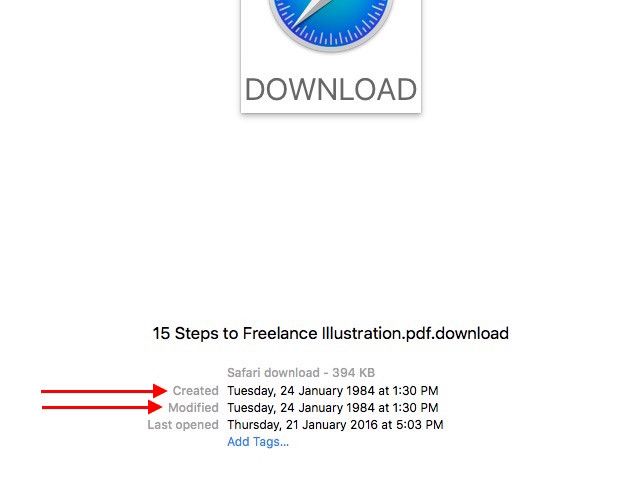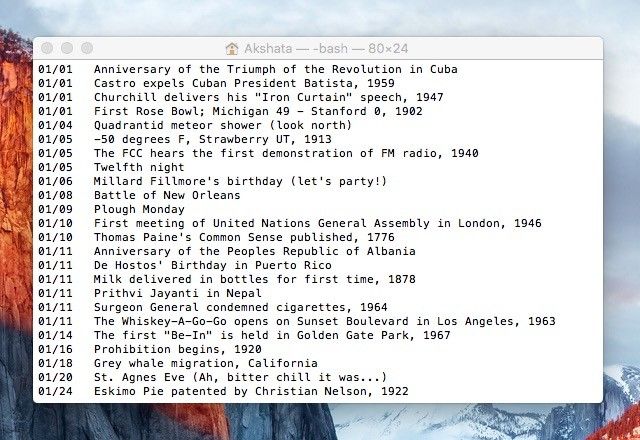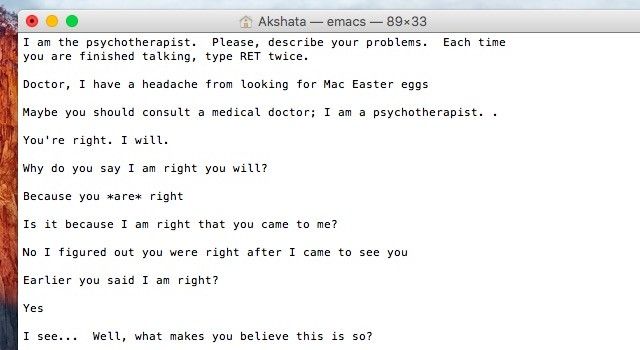Your Mac hides many features and informational tidbits from you, often in plain sight. Take for example these 20-year-old features that are still around on your Mac.
Surprised? There’s more where that came from. Let’s explore some other Mac facts and secrets that you might have missed.
How Do You Say OS X?
Have you been referring to your Mac’s operating system as OS-Ex? You're not alone, but it’s actually pronounced OS-Ten.
The use of X, the Roman numeral for ten, causes the confusion. The Mac has had OS versions 1 through 9, and the current version is the tenth one, with releases numbered 10.9, 10.10, and the latest, El Capitan, numbered 10.11. So if you think about it, OS-Ten makes perfect sense.
You can even ask OS X itself to clear up that confusion for you once and for all. Open the Terminal app, type
say os x
, and hit Enter to hear the correct way to say OS X.
What’s With the Weird Timestamp on Incomplete Downloads?
Have you ever noticed the Created and Modified timestamps on incomplete downloads on your Mac? Go ahead. Check them out now. They’ll read 24 January 1984 — the day Steve Jobs unveiled Apple’s first ever Macintosh computer.
There's a Hidden Effect to Minimize Dock Icons
You know that you can choose between the Genie and Scale effects to minimize dock icons (head to System Preferences > Dock to change it). Did you also know that there’s a third one that you can switch to? It’s called Suck and you’ll need to activate it from the terminal.
First, type this piece of code in a terminal window and hit Enter:
defaults write com.apple.dock mineffect -string suck
Next kill the dock:
killall -KILL Dock
You can also open Activity Monitor and force quit the dock, if you want. The dock will restart automatically and the next time you minimize a dock icon, you'll see the Suck effect in action.
While you’re trying this tweak, check out a few other terminal commands to customize your dock.
A Historical OS X Easter Egg
Open Terminal and type this in:
cat /usr/share/calendar/calendar.history
. After you hit Enter, you’ll see a long list of historic events corresponding to each day of the year. Educational!
The Original Macintosh Keyboard Was Missing A Few Buttons
I would never ever have managed to guess the answer to that one — arrow keys. That’s right. The original Mac keyboard had no arrow keys. The omission was of course intentional. Steve Jobs wanted it so for a couple of reasons:
- To get users comfortable with mouse usage, and
- to force software developers and designers to build applications that were suited to graphical user interfaces rather than command line usage.
Before Safari, Apple Used A Rival's Browser
You might think that Apple’s Safari has been the default web browser on the Mac since forever. But it has been around for only a little more than a decade — 2003, to be precise. Internet Explorer (yes!) for Mac was the default browser found on Apple computers from 1998 to 2003, thanks to a five-year agreement between Apple and Microsoft.
Before Internet Explorer made an appearance, Macs shipped with two other web browsers — Netscape Navigator and Cyberdog.
Need a Psychotherapist? Just Ask OS X
If you want a few laughs, try having a conversation with the virtual psychotherapist on OS X. To start a session, open the Terminal app and follow this sequence of steps:
-
Type
emacs - Press shift+esc and then press x
-
Type
doctor
Your virtual psychotherapy session is now live. We promise it’ll be amusing, and after some time, frustrating. Here’s a sample:
By the way, this feature is not specific to Macs. It works in the GNU Emacs text editor on other platforms as well.
Which Microsoft Product Made Its First Appearance on a Mac?
An early spreadsheet program called Microsoft Multiplan was the first product released on the Mac. It was later replaced by Excel in September 1987 — a full two years before it came to Windows. It looks like Microsoft loved Apple even back then.
The First Portable Mac Was Heavy
It weighed a whopping 16 pounds, or 7.2 kilograms. To put things in perspective, that’s approximately ten pounds heavier than the 17-inch MacBook Pro, which Apple dropped in 2012. The heaviest portable Mac right now is the MacBook Pro 15-inch (with Ret4ina Display). It weighs about 4.5 pounds (2 kilograms).
The Mac Portable turned out to be a flop product. In the next couple of years, Apple released a far better line of portable Macs — the PowerBook series, which set the stage for the much lighter and relatively cheaper Mac laptops that have since followed.
Cheetah Was the First “OS X Cat”
Before El Capitan, Yosemite, and Mavericks, OS X releases received code names based on big cats, and Cheetah was the first of those names. It was assigned to version 10.0. After Cheetah came Puma, Jaguar, Panther, Tiger, Leopard, Snow Leopard, Lion, and Mountain Lion, in that order.
Starting with Mavericks, subsequent OS X versions have been named after landmarks in California — the state that houses the Apple headquarters (in the city of Cupertino). Oh, and El Capitan is a rock formation (not a wrestler).
Hunting for More Easter Eggs?
Apple is not the only company to hide humorous or otherwise interesting elements in its products. Check out these other Easter eggs in various operating systems.
What's your favourite fun fact about Apple, the Mac or OS X?





